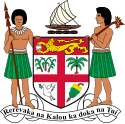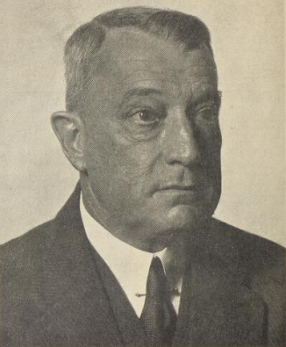 |
|---|
Legislative
|
|
General elections were held in Fiji on 28 April 1911. [1]
 |
|---|
General elections were held in Fiji on 28 April 1911. [1]
The Legislative Council consisted of eleven civil servants, six elected Europeans and two appointed Fijians. [2] Previously the six Europeans had been elected from three constituencies; Levuka (one seat), Suva (two seats) and a "Planters" constituency covering the rest of the colony (three seats). [2] However, prior to the 1911 elections, the Planters constituency was split into three single-member constituencies; Eastern, Northern and Southern. [1]
| Constituency | Candidate | Votes | % | Notes |
|---|---|---|---|---|
| Eastern | Adam Coubrough | 70 | 75.3 | Re-elected |
| J. McConnell | 23 | 24.7 | ||
| Informal votes | 1 | – | ||
| Levuka | John Maynard Hedstrom | 40 | 54.1 | Re-elected |
| David Robbie | 34 | 45.9 | ||
| Informal votes | 1 | – | ||
| Northern | Charles Wimbledon Thomas | 55 | 59.8 | Elected |
| E. Duncan | 37 | 40.2 | ||
| Southern | James Burton Turner | 80 | 49.4 | Elected |
| Leslie Edward Brown | 58 | 35.8 | Unseated | |
| E.F. Powell | 24 | 14.8 | ||
| Informal votes | 2 | – | ||
| Suva | Henry Marks | 139 | 46.6 | Elected |
| Henry Milne Scott | 85 | 28.5 | Re-elected | |
| George Fox | 74 | 24.8 | Unseated | |
| Source: Ali | ||||
The nominated members were appointed on 3 June. [3]
| Position | Member |
|---|---|
| Governor (President) | Francis Henry May |
| Agent-General of Immigration | Arthur Robert Coates |
| Attorney-General | Albert Ehrhardt |
| Chief Justice | Charles Major |
| Chief Medical Officer | George Lynch |
| Collector of Customs | John Kenneth Murray Ross |
| Colonial Secretary | Eyre Hutson |
| Commissioner of Lands | Dyson Blair |
| Commissioner of Works | Hugh Daniel Badcock |
| Inspector-General of Constabulary | Islay McOwan |
| Native Commissioner | William Sutherland |
| Receiver-General | Richard Sims Donkin Rankine |
| Fijian member | Joni Madraiwiwi I |
| Fijian member | Penaia Kadavu Levu |
| Source: Fiji Blue Book [3] | |

Since becoming independent of the United Kingdom in 1970, Fiji has had four constitutions, and the voting system has changed accordingly.

Elections in Guyana take place within the framework of a multi-party representative democracy and a presidential system. The National Assembly is directly elected, with the nominee of the party or alliance that receives the most votes becoming President.

The Legislative Council of Fiji was the colonial precursor to the present-day Parliament, which came into existence when Fiji became independent on 10 October 1970.

General elections were held in Fiji between 26 September and 8 October 1966, the last before independence in 1970 and the first held under universal suffrage. The result was a victory for the Alliance Party, which won 23 of the 34 elected seats. Its leader Kamisese Mara became the country's first Chief Minister the following year.

General elections were held in Fiji between 17 April and 4 May 1963. For the first time, women and indigenous Fijians were given the right to vote alongside the male European and Indo-Fijian population.

General elections were held in Fiji on 22 March and 8 April 1905.

General elections were held in Fiji on 23 March and 10 April 1908.

General elections were held in Fiji in June and July 1917.

General elections were held in Fiji in July, August and September 1920.

General elections were held in Fiji in 1929. They were the first in which Indo-Fijians were allowed to vote.

General elections were held in Fiji on 31 August 1932, although only one of the nine elected seats was contested.

General elections were held in Fiji in July 1937, the first in which an equal number of Europeans and Indo-Fijians were elected.

General elections were held in Fiji on 20 July 1940.

General elections were held in Fiji on 29 July 1944. The term of the Legislative Council elected in 1940 was due to end in 1943, but was extended by a year by the Governor.

General elections were held in Fiji in September 1947. Voting took place in the Northern and Western and Southern constituencies on 20 September, with voting in the Eastern constituency carried out between 15 and 22 September.

General elections were held in Fiji in August 1950. Voting took place in most locations on 26 August, and in the Lau and Lomaiviti Islands between 21 and 28 August.

General elections were held in Fiji in August 1956; voting took place in the Eastern constituencies between 11 and 18 August, and on 18 August in all other constituencies.

General elections were held in Fiji in September 1959, the last in which women and ethnic Fijians were still barred from voting. Voting took place in the Eastern constituencies between 5 and 12 September, and in the Northern and Western and Southern constituencies on 12 September.

Sir Henry Milne Scott was a Fijian lawyer, businessman, politician and international cricketer. Alongside Robert Crompton, Henry Marks and John Maynard Hedstrom, he was one of the 'big four' that heavily influenced the Fijian economy and political sphere in the first half of the 20th century.